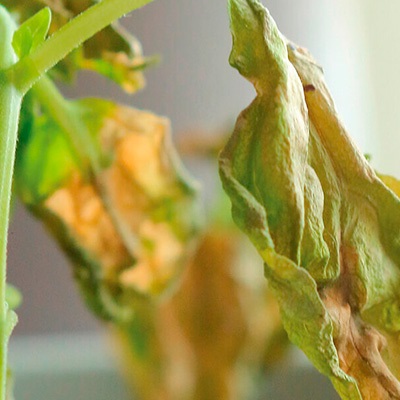
Fusariosis
WHAT IT IS AND HOW TO ELIMINATE
Plantas decorativas de jardín y/o interior
Fusariosis
Fusarium sp.
Pathogen:
Fungus
Type:
Risk to the plant:
HIGH
Fusariosis

WHO CAUSES IT?
Fusarium sp. It is a genus of filamentous fungi that lives both in the soil and in plant tissues. It is characterized by producing spores called macroconidia and microconidia, as well as resistance structures known as chlamydospores, which can survive in adverse conditions for long periods. These structures allow it to persist in plant remains and contaminated soil. When conditions are favorable, it germinates and colonizes weakened roots or tissues, penetrating wounds or through natural openings. From there, it invades the vascular tissues, especially the xylem, moving through the conductive vessels and blocking the flow of water and nutrients. This internal colonization favors the appearance of characteristic symptoms in plants, which progressively worsen. The pathogen can also reproduce and be released back into the environment through spores that are spread by water, tools or vectors.
SYMPTOMS
Fusarium wilt is a disease caused by various species of Fusarium that affects a wide range of plants. In plants, it causes progressive wilting, chlorosis, leaf necrosis and general weakening. The roots and base of the stem may show rot, with internal discolorations in the conducting vessels. The progression of the disease compromises growth and productivity, and in many cases ends with the death of the plant.
- Progressive wilting
- Leaf yellowing
- Necrosis in leaves and stems
- Brown stretch marks in the vascular tissue
- Delayed growth
- Root rot
- Premature leaf fall
- Structural weakening of the plant
- Total collapse in advanced stages



DEVELOPMENT CONDITIONS
Temperature:
24°C - 30°C
Humidity:
65% - 90%
HOW IS IT SPREAD?
Irrigation water, Contaminated soil, Infected plant remains, Agricultural tools, Wind, Vector insects, Contaminated seeds
HOW TO ELIMINATE IT?
Home treatments
Natural allies
There are no natural allies
Chemical treatments
RECOMMENDED PRODUCTS TO ELIMINATE THE PEST
PLANTAS REPELENTES
-
RECOMMENDATIONS
- Use new or disinfected substrate if you are going to plant in pots.
- Rotate crops, do not always plant the same thing in the same place.
- Avoid flooding the soil, excess moisture favors the fungus.
- Choose resistant varieties if they are available for your cultivation.
- Do not plant in soils where plants have already dried out due to this disease.
- Improve soil drainage by adding sand or organic matter.
- If a plant is severely affected, remove it, roots and all, and dispose of it away from the garden.














